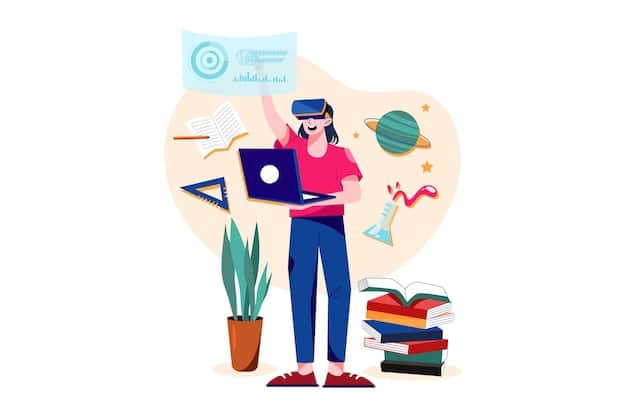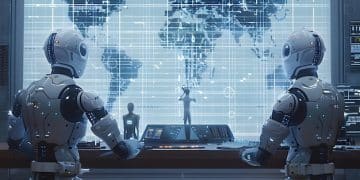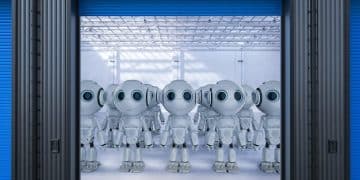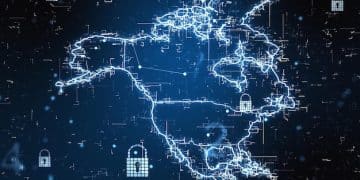The Future of Work: Automation’s Impact on the US Job Market by 2025

The future of work in the United States by 2025 will be significantly reshaped by automation, leading to a dynamic shift in job roles, requiring new skills, and emphasizing the importance of human-AI collaboration across various sectors.
As we approach 2025, the landscape of employment in the United States is undergoing a profound transformation. The rise of automation, driven by advancements in artificial intelligence, robotics, and machine learning, is not merely a technological trend but a fundamental force reshaping industries and careers. Understanding The Future of Work: How Automation is Changing the US Job Market by 2025 is crucial for individuals, businesses, and policymakers alike to navigate this evolving professional world effectively.
The Automation Revolution: Beyond Repetitive Tasks
The concept of automation often conjures images of factory floors dominated by robotic arms, meticulously assembling products. While this remains a significant application, the automation revolution extends far beyond repetitive physical labor. By 2025, automation’s influence will permeate white-collar professions, service industries, and creative fields, taking on tasks that were once considered exclusively human domains.
This expansion is fueled by increasingly sophisticated algorithms and machine learning models capable of complex data analysis, pattern recognition, and even decision-making within defined parameters. The goal is not necessarily to replace human workers entirely, but to augment their capabilities, streamline operations, and reduce errors. This shift necessitates a re-evaluation of traditional job structures and skill sets, pushing the workforce towards roles that prioritize uniquely human attributes like creativity, critical thinking, and emotional intelligence.
Deepening Reach of Automation
By 2025, automation’s reach will continue to expand into several key areas:
- Cognitive Automation: This involves technologies that simulate human thought processes, such as natural language processing (NLP) for customer service bots and data analysis for financial forecasting.
- Robotic Process Automation (RPA): Software bots automate highly repetitive, rule-based digital tasks, freeing up human staff for more strategic work.
- Physical Robotics: Advanced robots with enhanced dexterity and AI will perform tasks in logistics, healthcare, and exploration.
The integration of these technologies implies a future where human-machine collaboration becomes the norm. Workers will increasingly interact with automated systems, requiring new forms of digital literacy and adaptability. This integration is designed to improve efficiency and output, not just cut costs, although that often remains a significant driver for adoption.
The pace of this technological integration varies across industries, influenced by factors such as capital investment, regulatory frameworks, and the inherent complexity of tasks. Industries with high volumes of data-driven, rule-based operations are likely to see faster adoption of advanced automation, while sectors reliant on nuanced human interaction may experience a slower, more gradual integration.
Ultimately, the deeper reach of automation by 2025 isn’t just about robots and software; it’s about a fundamental redefinition of how work is structured, performed, and valued in the US economy. It demands foresight and proactive adaptation from both employers and employees.
Shifting Skill Demands: The Rise of Human-Centric Abilities
As automation assumes a growing share of routine and analytical tasks, the demand for specific human skills is undergoing a significant transformation. By 2025, the US job market will place a premium on competencies that automation cannot easily replicate. These human-centric abilities will become the cornerstone of a resilient and adaptable workforce.
The emphasis will shift from rote knowledge and manual dexterity to a deeper engagement with problem-solving, emotional intelligence, and complex communication—skills that require nuanced understanding and interpersonal dynamics, areas where machines still heavily rely on human input and supervision. This transition is not merely about learning new software, but fundamentally evolving how we think about professional contributions.
Key Skills for the Automated Era
Preparing for 2025 means cultivating skills that empower individuals to work alongside, rather than be replaced by, automated systems. Some of the most critical include:
- Critical Thinking and Judgment: The ability to analyze information, identify biases, and make informed decisions, especially in ambiguous situations where automated systems might falter.
- Creativity and Innovation: Generating new ideas, developing novel solutions, and approaching challenges from unique perspectives. This is crucial for developing new products, services, and strategies.
- Complex Problem-Solving: Tackling ill-defined problems that require multiple approaches, collaboration, and adapting to unforeseen circumstances.
- Emotional Intelligence and Collaboration: Understanding and managing one’s own emotions, empathizing with others, and effectively working in diverse teams, often remotely and across different cultures.
- Digital Literacy and Data Fluency: While not purely human-centric, the ability to understand, interpret, and leverage data, as well as interact seamlessly with digital tools, is fundamental in an automated environment.
Education and training systems will play a pivotal role in equipping the current and future workforce with these essential competencies. Lifelong learning initiatives, micro-credentials, and vocational training programs focused on these areas will become increasingly vital to ensure workforce readiness and individual career progression.
Furthermore, businesses will need to invest in upskilling and reskilling programs for their existing employees, transforming their talent pools to meet the demands of an increasingly automated future. This proactive investment is crucial for maintaining productivity and fostering employee loyalty in a rapidly changing labor market.
In essence, the future workforce will be defined not by what they know, but by how effectively they can learn, adapt, and apply uniquely human attributes in concert with advanced technological tools.

Sectoral Impacts: Winners and Losers in the Automation Race
The impact of automation will not be uniformly distributed across the US job market by 2025. Certain sectors are poised for significant disruption, leading to job displacement in some areas, while others will experience growth and the creation of entirely new roles. Understanding these sectoral shifts is vital for strategic planning and career development.
Industries heavily reliant on repetitive, predictable tasks—whether physical or cognitive—are generally more susceptible to automation. Conversely, sectors requiring complex human judgment, creativity, or intricate interpersonal interactions are likely to see job augmentation rather than outright replacement. This nuanced impact underscores the complexity of predicting exact job outcomes.
Industries Undergoing Major Transformation
Various sectors will witness distinct transformations:
- Manufacturing and Logistics: Already heavily automated, these sectors will see continued advancements in robotics and AI, leading to fewer manual labor roles but increased demand for automation engineers, data analysts, and maintenance technicians.
- Retail and Food Service: Self-checkout kiosks, automated inventory management, and robotic food preparation will reduce the need for entry-level positions, pushing remaining roles towards customer experience and specialized service.
- Customer Service: Chatbots and AI-powered virtual assistants will handle routine inquiries, while human agents focus on complex problem-solving and empathetic interactions.
- Healthcare: AI for diagnostics, robotic surgery assistants, and automated record-keeping will enhance efficiency, but human roles in patient care, therapy, and complex medical decision-making will remain central.
- Finance and Accounting: Automated data entry, transaction processing, and basic auditing will free up financial professionals for strategic analysis, client advisory roles, and complex compliance.
- Creative and Technical Fields: Areas like software development, data science, and content creation might see AI tools assist in code generation or content drafts, but human oversight, creativity, and strategic direction will be indispensable.
While some jobs may be lost, it’s crucial to acknowledge the “new work” that automation creates. This includes roles directly involved in developing, deploying, and maintaining automated systems, as well as positions focused on human-AI collaboration and interpreting AI outputs. The net effect on employment is complex and will depend on factors like economic growth, policy decisions, and the pace of technological adoption.
Policymakers will face the challenge of managing job transitions, providing retraining opportunities, and ensuring social safety nets are adequate. Businesses, on the other hand, must proactively identify which roles are vulnerable to automation and implement strategies for workforce transformation, including reskilling and internal mobility programs to retain valuable talent.
The Imperative of Lifelong Learning and Reskilling Initiatives
In a job market profoundly shaped by automation, the traditional model of education—completing studies and then applying that static knowledge for a career—is becoming increasingly obsolete. By 2025, lifelong learning and continuous reskilling will transition from optional benefits to fundamental requirements for professional relevance and individual career resilience in the US.
This imperative stems from the accelerating pace of technological change, which rapidly renders certain skills obsolete while simultaneously creating demand for new ones. Individuals and organizations alike must embrace a mindset of continuous adaptation and investment in human capital to thrive in this dynamic environment. The ability to learn, unlearn, and relearn will be a critical differentiator.
Pathways for Continuous Skill Development
To meet the demands of an evolving job market, several avenues for lifelong learning will become prominent:
- Online Learning Platforms: MOOCs (Massive Open Online Courses) and specialized platforms offer flexible access to cutting-edge skills, from data science to digital marketing and AI ethics. Their accessibility makes them vital for broad upskilling.
- Micro-credentials and Certifications: Shorter, focused programs that validate specific competencies, allowing individuals to quickly acquire in-demand skills without committing to lengthy degree programs.
- Employer-Sponsored Training: Progressive companies will invest heavily in internal upskilling and reskilling programs, recognizing that retaining and transforming their existing workforce is often more cost-effective than constant external hiring.
- Government and Non-Profit Initiatives: Public-private partnerships will emerge to provide accessible training for workers displaced by automation or those in vulnerable sectors, focusing on skills aligned with future job growth areas.
- Apprenticeships and Experiential Learning: Blending theoretical knowledge with practical, on-the-job application will remain a powerful way to develop highly specialized and adaptable skills.
The success of these initiatives relies on several factors: clear communication of future skill needs, flexible learning modalities that accommodate diverse learners, and robust support systems for career transitions. Moreover, individuals themselves must cultivate a proactive approach to their own development, embracing curiosity and a growth mindset.
For individuals, investing time and effort in continuous learning offers a tangible return: enhanced employability, greater career mobility, and the ability to adapt to unforeseen changes. For employers, a commitment to employee development fosters innovation, improves morale, and creates a more agile and competitive workforce.
Ultimately, 2025 will underscore that education is not a finite event, but an ongoing journey essential for navigating the complexities and opportunities presented by an automated future.

Ethical and Societal Implications: Beyond Employment Rates
The widespread adoption of automation by 2025 extends beyond mere employment statistics, raising profound ethical and societal questions that demand careful consideration and proactive policy responses. These range from concerns about job displacement and income inequality to issues of algorithmic bias, data privacy, and the very nature of human interaction in an increasingly automated world.
Ignoring these implications would be short-sighted, potentially exacerbating existing societal divides and undermining public trust in technological progress. A balanced approach is required, one that harnesses the benefits of automation while mitigating its potential adverse effects on individuals and communities.
Addressing the Broader Impact of Automation
As automation becomes more pervasive, several critical societal discussions will intensify:
- Economic Inequality: Automation could disproportionately benefit highly skilled workers and capital owners, potentially widening the gap between the affluent and those in lower-skilled positions. Policies like universal basic income (UBI) or strengthened social safety nets are often debated as potential solutions.
- Algorithmic Bias: AI systems learn from data, and if that data reflects existing societal biases (e.g., in hiring, lending, or criminal justice), the AI can perpetuate or even amplify these biases, leading to unfair outcomes. Developing ethical AI frameworks and regulations will be crucial.
- Data Privacy and Security: Increased automation relies on vast amounts of data, raising concerns about how this data is collected, stored, and used, and the risks of breaches. Robust privacy laws and individual control over personal data will be paramount.
- The Nature of Work and Leisure: As machines take over more tasks, it could free up human time for new pursuits, creativity, or leisure. However, it also raises questions about meaning, purpose, and how societies will structure themselves if traditional work declines for a significant portion of the population.
- Digital Divide: Access to technology and the skills to use it effectively will become even more critical. There’s a risk that communities or individuals without adequate access or training could be left further behind.
These challenges are not exclusively technological; they are fundamentally social, economic, and political. Addressing them requires a multi-stakeholder approach involving governments, businesses, educators, and civil society. Proactive policy development focusing on ethical guidelines for AI, robust workforce transition programs, and investments in inclusive infrastructure will be essential.
Furthermore, public discourse around automation needs to be nuanced, moving beyond alarmist predictions or overly optimistic portrayals. Fostering a broader understanding of both the opportunities and the risks can help societies make informed choices about how to best integrate these powerful technologies into the fabric of daily life.
By 2025, how the US addresses these ethical and societal implications will significantly influence the trajectory of its automated future and the well-being of its citizens.
Navigating the Future: Strategies for Individuals and Organizations
Navigating the complex landscape of automation’s impact on the US job market by 2025 requires deliberate and proactive strategies from both individuals and organizations. A passive approach risks being left behind, while a strategic one can unlock new opportunities and foster adaptability in an ever-changing professional environment.
The key lies in understanding that this is not a one-time adjustment, but an ongoing process of transformation. Both individuals building their careers and organizations shaping their workforces must embrace continuous learning, flexibility, and a forward-looking perspective to harness automation’s potential for growth and efficiency.
Crucial Strategies for Adaptation
To successfully navigate the automated future, consider the following:
For Individuals:
- Embrace Lifelong Learning: Continuously seek out new skills, especially those related to data analysis, AI literacy, and uniquely human capabilities like critical thinking and emotional intelligence. Online courses, certifications, and workshops are invaluable resources.
- Cultivate Adaptability: Be open to career transitions, new job roles, and evolving responsibilities. The ability to pivot and learn quickly will be highly valued.
- Network and Collaborate: Build strong professional networks. Collaboration, both with humans and AI, will be central to future work models.
- Focus on Uniquely Human Skills: Prioritize developing creativity, complex problem-solving, negotiation, and empathy – areas where AI still lacks true proficiency.
For Organizations:
- Strategic Workforce Planning: Proactively assess which jobs are susceptible to automation and identify new roles that will emerge. Develop clear transition plans for employees.
- Invest in Reskilling and Upskilling: Implement robust internal training programs to equip your existing workforce with the skills needed for future roles, fostering a culture of continuous learning.
- Foster Human-AI Collaboration: Design work processes that effectively integrate AI tools, allowing employees to leverage technology for enhanced productivity and innovation. Encourage employees to view AI as a partner, not a competitor.
- Prioritize Ethical AI Deployment: Develop clear guidelines and oversight for AI usage to ensure fairness, transparency, and accountability, building trust among employees and customers.
- Cultivate an Adaptive Culture: Encourage experimentation, continuous improvement, and a willingness to embrace change throughout the organization. Flexibility will be key to long-term success.
The symbiotic relationship between human ingenuity and technological prowess will define success in 2025. By implementing these strategies, both individuals and organizations can transform potential challenges into opportunities, building a more resilient, dynamic, and productive future of work.
| Key Area | Brief Description |
|---|---|
| 💡 Automation Scope | Extending from manual tasks to cognitive functions like data analysis and customer service. |
| 🧠 Skill Shift | Growing demand for critical thinking, creativity, and emotional intelligence. |
| 📈 Sector Impact | Disruption in retail, manufacturing; creation of new roles in tech and AI integration. |
| 📚 Re-skilling | Lifelong learning and continuous training are essential for workforce adaptability. |
Frequently Asked Questions
▼
No, automation is unlikely to eliminate all jobs. While certain routine or predictable tasks are at higher risk of automation, new jobs requiring uniquely human skills like creativity, critical thinking, and emotional intelligence will emerge. The focus will shift towards human-AI collaboration rather than full replacement in most sectors.
▼
By 2025, skills such as complex problem-solving, critical thinking, creativity, emotional intelligence, and digital literacy will be paramount. The ability to adapt, learn continuously, and effectively collaborate with AI tools will also be highly valued across various industries in the US job market.
▼
Entry-level jobs, especially those involving repetitive tasks in sectors like retail, food service, and logistics, are likely to be significantly impacted by automation. While some roles may diminish, new entry points emphasizing customer experience, technical support for automated systems, or creative problem-solving will likely arise.
▼
Governments play a crucial role through policy development, investing in education and retraining programs, fostering public-private partnerships, updating social safety nets, and ensuring ethical guidelines for AI implementation. Their efforts aim to mitigate job displacement and promote an equitable transition for the workforce.
▼
Individuals can best prepare by committing to lifelong learning, embracing reskilling and upskilling opportunities, focusing on uniquely human capabilities, and cultivating adaptability. Networking and understanding how automation integrates into their specific industries will also provide a significant advantage in the evolving job landscape.
Conclusion
The journey towards 2025 will undoubtedly solidify automation’s transformative influence on the US job market. This isn’t merely a technological upgrade but a societal recalibration demanding adaptability, continuous learning, and a proactive approach from all stakeholders. By understanding the shifting skill demands, the nuanced sectoral impacts, and the broader ethical implications, individuals, businesses, and policymakers can collaboratively shape a future of work that harnesses automation’s potential for prosperity while prioritizing human dignity and well-being.





